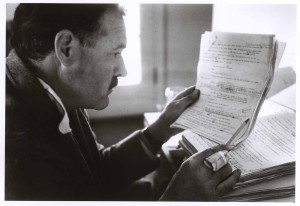
Category: Hemingway and the arts
Lillian Ross’ Profile of Hemingway
How Do You Like It Now, Gentlemen?
The above is a link to the Lillian Ross interview with Hemingway, a sad betrayal of his kindness and friendship to a young writer.
There’s a famous profile of Hemingway that was published on May 13, 1950 in The New Yorker done by a very young journalist at the time named Lillian Ross. Hemingway had helped her with her first big article about Sidney Franklin, the first Jewish-American bull fighter. Hemingway and Lillian Ross became friends and as Hemingway often did, he enjoyed taking this younger, very smart woman under his wing and addressing her as “daughter” and sharing some of the things that he knew with her.


Lillian Ross started working at The New Yorker in 1945 and seemed particularly adept at charming her subjects into saying things they might otherwise not say. She asked to do a profile on Hemingway, who needed the publicity like a hole in the head, but he agreed, hoping to help her career. She shadowed him for months and in particular went with him to New York on a three-day tour. Hemingway viewed it all as a lark.
Here’s where my objectivity stops. As I noted in my opening post three years ago, while I try to be objective about Hemingway and his flaws, which were many, I’m on his side. I’m not neutral. Lillian Ross’ article made him look like a self-involved jerk, almost ignorant. He thought she was his friend.

In that article are statements by Hemingway such as “Book is like engine. We have to slack her off gradually.” And then there’s this repeated gem apropos of nothing, “How do you like it now, Gentlemen.” Ross always maintained that it was an affectionate portrait of a wonderful writer, but, in essence, it made fun of him and it made him look ludicrous. If that’s how she saw him, then so be it. The press is free and she can write what she’d like to write, but don’t pretend it was an “affectionate” portrayal.

At the time, Lillian Ross was 24 years old and it was the opportunity of a lifetime to profile Ernest Hemingway, the biggest writer of the day. Years later, The New York Times wrote that “The effect of her severely unadorned portrait was to create an impression of an unpleasant egotist, a celebrity who, to a pathetic extent, had identified himself with his own public image.” As one of Hemingway’s biographers, Jeffrey Meyers, wrote later that she’d repaid his generosity with meanness and malice, and established her reputation at his expense.” Quoting Meyers again, he notes that she never recorded or revealed the serious and sensitive side of his character and chose instead to portray him as a boring braggart. So how do you like it now, Gentlemen?

When Lillian published the profile in book form shortly after Hemingway’s death, she still claimed it was a sympathetic portrait of a great, loveable man. Few readers were fooled. She also claimed he was fine with it. True. He read it before publication; felt the dye was cast so said little; and passed on it, but it was not really “fine” with him. He was hurt.

If you look at the cover, could Lillian have picked a less attractive, less compelling photo? In a reissue, there’s a nice photo of Hemingway and Lillian on the front, but I believe the original shows a Hemingway looking out of it and bizarre. If I’m wrong on this, someone out there probably knows, so please correct me.
Lillian Ross has written a new book in which Ross has collected selected pieces, including the Hemingway profile along with newer works spanning her sixty year career as a journalist. It is called “Reporting Always: Writings From The New Yorker.” It was published last week by Scribner’s, which, of course, is Hemingway’s publisher.
I can’t help being wounded for him. He trusted her and thought they were having some fun together and that she would not portray him as a lout. It’s his fault in part, no question for being too casual and not foreseeing damage for not taking the interview seriously. However, his loyalty was betrayed.
Take a read and see what you think. Perhaps you’ll see it differently. I’m happy to stand corrected or confronted.
Love,
Christine

Play in LA about Hem and Scott: UPDATE RE CAST!

If you are in the Toluca Lake area, this looks good, fun, thought provoking! There is a new cast member playing F. Scott Fitzgerald: now played by Kevin Blake. Please go to see it if you can! I have heard good things.
Love, Christine
Scott and Hem is a brilliant play about two brilliant literary giants– F. Scott Fitzgerald and Ernest Hemingway– being presented at the Falcon Theatre from Oct. 14 to Nov. 15. The show puts the spotlight on F. Scott Fitzgerald (Kevin Blake) and Ernest Hemingway (Ty Mayberry) wrestling with the personal destruction that comes with their sparks of art and the perils of their creativity. It is a combative comedy fueled by Scott and Hem’s friendship and intense rivalry. The two legendary authors reunite in 1937 at Fitzgerald’s home in Hollywood’s fabled Garden of Allah, chaperoned by the saucy Ms. Eve Montaigne (Jackie Seiden). There they explore their mysterious bond and the genius that first brought them together, and ultimately tore them apart. It is written by Mark St. Germain, and Dimitri Toscas is at the helm of the show so perfectly cast. Scott and Hem is presented by Garry Marshall’s Falcon Theatre in Toluca Lake. Go to www.falcontheatre.com. #
Hemingway Exhibit at the Morgan Library/Museum Sept ’15-Jan 31 ’16

#Hemingwayexhibit
Oh, the fun of this. About half of the items in the exhibit are being borrowed from the Kennedy Library (Boston) Collection. Some were private letters so don’t be too hard on him. If letters you wrote to a close friend or lover were made public .they might not include your most eloquent turns of phrase. If you can manage, this will be a great stroll through Hemingway lore and history.

Veterans get help from Hemingway Source
Writing Retreat for Military Veterans at Hemingway-Pfeiffer Gets Underway July 24-26
For an intensive weekend, Vets can write and gain access to their creative side at the homestead of Pauline Pfeiffer, Hemingway’s second wife. her Uncle Gus was a generous patron to Hemingway in his earlier years and in fact, Hem dedicated A Farewell to Arms to Gus Pfeiffer. What a great idea for giving back and enriching the community. Read more.

What’s Percolating in the Hemingway World?

I subscribe to a number of RSS feeds and google alerts that keep me posted on all things Hemingway. So here are a few random developments.
1) Mariel Hemingway is producing a movie of Hemingway’s last book, A Moveable Feast, finished after his death and published initially in 1964. (Hemingway died in 1961).
2) Andy Garcia is wrapping up his movie about Hemingway and his boat captain, Gregorio Fuentes.
3) Coming out in the Fall is a possible Oscar contender called GENIUS, about

Hemingway’s editor Maxwell Perkins (played by Colin Firth) and Tom Wolfe (played by Michael Fassbinder). Dominic West plays Hemingway. All Brits playing Americans.
4) The Cuban government is working on how much access to permit to the Finca Vigia. Right now, the public can peer through windows but cannot go in.
5)Thomasville is having a Hemingway Outdoor furniture collection.
6) A man named Robert Wheeler spent a winter four years ago in Paris, retracing Hemingway’s time there in the early 1920s. He took a camera. And now he’s publishing a book, due out April 7. I can’t wait to se e it.
e it.

7) Before announcing the winner of the 2015 PEN/Hemingway Award for debut fiction, Beacon Press director Helene Atwan, administrator of the prize, made note of a major gift from the Hemingway family. The cash prize attached to the award was doubled this year to $20,000. Patrick, Hemingway’s remaining son, was on hand to assist in distributing the awards which took place at the JFK Library, home of he Hemingway Collection.


Hemingway and Cuba Opens Up
 It appears that for the first time in decades, Cuba will be open to Americans and others around the world. In reviewing some of the recommended sights to see in Cuba for those eager to take a look, the Finca Vigia is always prominently listed. For those who followed earlier posts, you may recall that when Hemingway and his wife, Mary, were visiting in the U.S., they were abruptly advised by the FBI that they would not be allowed to return.
It appears that for the first time in decades, Cuba will be open to Americans and others around the world. In reviewing some of the recommended sights to see in Cuba for those eager to take a look, the Finca Vigia is always prominently listed. For those who followed earlier posts, you may recall that when Hemingway and his wife, Mary, were visiting in the U.S., they were abruptly advised by the FBI that they would not be allowed to return.


After Hemingway’s death, Mary was permitted by arrangement through the auspices of President Kennedy to return to the farm to pack up some critical items. When she and Hemingway left, the phonograph still had the last record they played on it. She took many papers, but furnishings remained. Hemingway was devastated to leave his staff high and dry as he was close to most of them and he was devastated to lose his Cuban house. He knew that something bad was coming as he saw the protests against America and did feel that probably his tenure there was not going to be very long. However, the suddenness with no preparation was breathtaking.
Hemingway was on J. Edgar Hoover’s watch list for years because of his residence in Cuba. Despite some claims to the contrary, Hemingway was far from close to Fidel Castro. They met a few times. I’ve read that they were “fishing” pals but everything else I’ve read does not suggest that that’s the case. If anyone reading this knows more than I do on this point, feel free to correct me or throw some light on that point.


The Cubans adore Hemingway. They always have. Hemingway’s house was in a small run-down town outside Havana, but he frequented Havana often. He and Martha Gelhorn and later his fourth wife, Mary, renovated the house and made it lovely and comfortable. It fell into disrepair after Hemingway left and only recently, through the auspices of Maxwell Perkins’ granddaughter, Jenny, have serious efforts been made to bring it back to its former loveliness. It’s twelve acres on a Cuban hillside, with many rooms opening to patios or with large windows to let in the warm, humid air that he enjoyed. I just read an article by Reed Johnson published in World News of The Wall Street Journal. Mr. Reed noted “perhaps no work of art is more emblematic of the countries’ (U.S. and Cuba) tangled artistic affinities than Ernest Hemingway’s Pulitizer Prize winning 1952 novel “The Old Man in the Sea.” In Hemingway’s taut masterpiece, Santiago, an aging Cuban fisherman and a New York Yankees fan, engages in an epic battle with a giant marlin, with his spiritual idol, Joe DiMaggio, as his invisible first mate. Hemingway’s portrait of the valiant Cuban is affectionate, respectful and intimately knowledgeable, qualities often lacking in U.S.-Cuban politics, but abundant in U.S.-Cuban art.”
All in all, I hope my own future holds a trip to Cuba and Finca Vigia.



